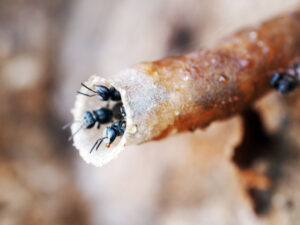As their name reveals, stingless bees do not sting. But not being able to sting does not make them defenceless. The defence strategies of stingless bees consist of several components that ensure an effective defence of the queen, her brood and the stores.
First: the nest. Stingless bees choose very protected places to build a nest. These could be crevices in rocks, hollowed tree trunks or underground cavities that cannot be found and opened easily. Nests can be accessed only through a single narrow entrance tube that is easy to protect. This leads to the second component: guards.

As seen in the picture, guarding bees line up in the nest entrance tube and discriminate between friend and foe. The entrance is open for nestmates that frequently pass with collected pollen and nectar. A non-nestmate, however, is not welcomed and the bees might attack or retreat. In case of an attack, guards fly out of the nest, hover in front of the entrance and bite the intruder. Along with the bite they set free an alarm pheromone that recruits further bees to join in the defence. Guards might also carry sticky resin on their hind legs which can either be applied directly to the intruder to immobilize it or be used to quickly close the nest entrance. In the latter case, the bees simply retreat in the nest and wait until the danger is over.
Despite the various defence strategies, most species are very calm and super harmless to humans. That is why it is so great to work with them! You would never swell or experience the pain honeybee venom causes
